![]()
![]()
![]()
Use LEFT and RIGHT arrow keys to navigate between flashcards;
Use UP and DOWN arrow keys to flip the card;
H to show hint;
A reads text to speech;
75 Cards in this Set
- Front
- Back
|
What is the primary function of the respiratory system?
|
gas exchange between air and circulating blood
• lungs - provide gas exchange "interface" between air & blood → supply body with O₂ and dispose of CO₂ |
|
|
What is the secondary function of the respiratory system?
|
acid-case balance (by regulating CO₂ in the blood)
|
|
|
The respiratory system consists of ___ and ___ zones
|
conducting and respiratory zones
|
|
|
conducting zone
|
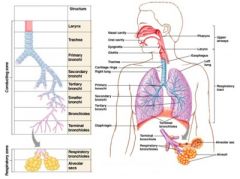
from nasal cavity to terminal bronchioles "dead space"
• maintenance of open airway • humidity • adjust temperature • cleanse |
|
|
respiratory zone
|
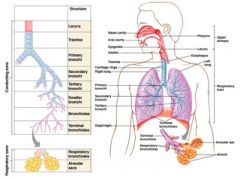
respiratory bronchioles and alveoli
• site of gas exchange |
|
|
respiratory muscles
|
diaphragm and other muscle that promote ventilation
|
|
|
ANS regulates smooth muscle to control _____ diameter
|
ANS regulates smooth muscle to control bronchiole diameter
• controls airflow & resistance in lungs |
|
|
bronchodilation
|
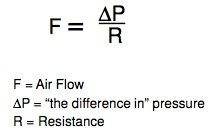
controlled by SNS → reduces resistance
|
|
|
bronchoconstriction
|
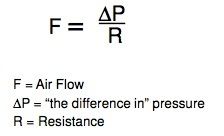
controlled by PNS and histamine release (allergies) → increases resistance
|
|
|
What is alveoli?
|
air-filled pockets within lungs where gas exchange takes place
• ~300 million alveoli • account for most of lung's volume • provide tremendous surface area for gas exchange |
|
|
Alveoli are patrolled by _____ _____ (dust cells) - phagocytize microbes
|

alveolar macrophages
|
|
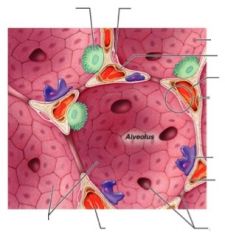
What are Type 1 cells?
|

thin, delicate endothelial cells
|
|
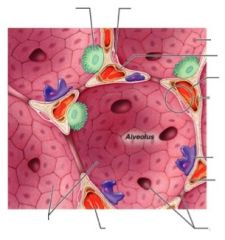
What are Type 2 cells?
|

produce surfactant (oily secretion - coats epithelium & reduce surface tension)
|
|
|
Surface tension
|
caused by attraction of H₂O molecules to each other (collapses alveoli) (premature babies - immature Type 2 cells = little/no surfactant)
|
|
|
Pulmonary capillaries
|
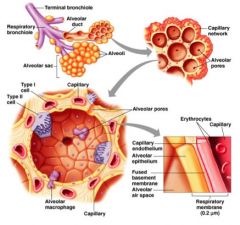
exchange CO₂ and O₂ with alveoli
• capillaries surround alveoli |
|
|
Respiratory Membrane
|
thin membrane of alveoli where gas exchange takes place (air-blood interface)
|
|
|
What are the three layers that gases must diffuse across?
|

1. Type 1 alveolar cells
2. Fused basal laminae between alveolar and endothelial cells 3. Endothelial cells of capillary |
|
|
Blood supply to the lungs: pulmonary circuit
|
purpose is gas exchange (also nourishes respiratory membrane)
pulmonary arteries → pulmonary capillaries → pulmonary veins |
|
|
Blood supply to the lungs: systemic circuit
|
purpose is to nourish lung tissue
Bronchial arteries → Bronchial capillaries → Pulmonary veins |
|
|
Each lung is located within a double-layers _____ membrane
|
serous
|
|
|
Visceral pleura
|
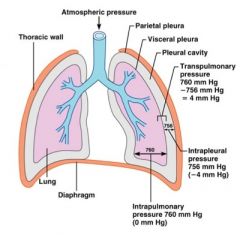
lines outer lung surface
|
|
|
Parietal pleura
|
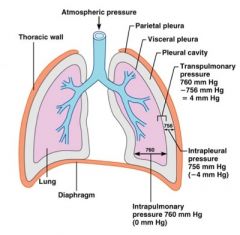
lines inner surface of thoracic wall
|
|
|
Thoracic wall:
|
• floor - diaphragm
• circumference - ribs & intercostals |
|
|
The right and left pleural cavities are separated by the _____
|
mediastinum
|
|
|
Each pleural cavity holds a long and lungs function ____
|
independently
|
|
|
pleural cavity
|
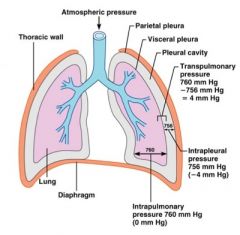
holds serous fluid that reduces friction as lungs inflate/deflate
|
|
|
What are the two principles affecting air movement?
|
atmospheric pressure and Boyle's Law
|
|
|
Atmospheric Pressure
|
(Patm) ~ weight of the Earth's atmosphere (on our bodies and everything around us)
• affects air movement into and out of our lungs • our lungs have their own pressure that varies between above and below atmospheric pressure as we breathe |
|
|
Respiratory Pressure
|
is describe relative to Patm
• Negative respiratory pressure is pressure < Patm • Positive respiratory pressure is pressure > Patm |
|
|
Boyle's Law
|
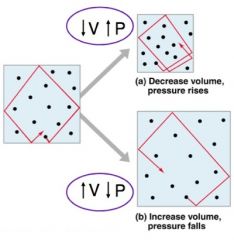
defines the relationship between gas pressure and volume
↓ V of container: • each molecule travels same distance within a time period • hit wall more frequently • molecules exert more pressure on container • = ↑ P |
|
|
Respiratory cycle
|
1 inspiration (inhalation) + 1 expiration (exhalation)
causes volume changes in thoracic cavity (with expansion or contraction of diaphragm or rib cage) that create changes in pressure |
|
|
Mechanics of Breathing
|
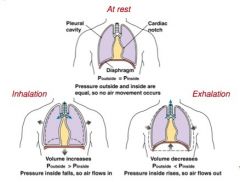
based on pressure differences (△P) between air in lungs and atmosphere during on Respiratory Cycle
|
|
|
What is the normal atmosphere pressure?
|
1 atm at sea level = 760 mm Hg
|
|
|
intra-alveolar pressure (Palv)
|
pressure of the lungs (within alveoli)
• measured relative to atmosphere pressure |
|
|
During relaxed breathing ....
|

inhalation = −1 mm Hg inside lungs
exhalation = +1 mm Hg inside lungs |
|
|
At rest ("Quiet" inspiration/expiration) the most important muscles are:
|
diaphragm and external intracostal muscles of the ribs
|
|
|
accessory respiratory muscles →
|
activated only when respiration increases significantly ("forced" inspiration/exhalation)
|
|
|
Quiet inspiration
|
diaphragm and external intercostal muscles (inspiratory muscles) contract and the rib cages rises
|
|
|
Quiet expiration
|
inspiratory muscles relax and the rib cage descends due to gravity
|
|
|
What are some physical properties of the lungs?
|
elasticity, compliance, and airway resistance
|
|
|
What is elasticity?
|
stretching force
• inward recoil force of lungs due to elastic tissue and surface tension of fluid lining alveoli |
|
|
What is compliance?
|
ease of expansion
• increase compliance → easier to expand lungs → decrease work of breathing |
|
|
What is airway resistance?
|
depends of diameter of lungs
|
|
|
Respiratory system adapts to changing oxygen demands by varying:
|
• number of breaths per minute (respiratory rate) (
|
|
|
respiratory rate
|
number of breaths per minute
average = 12 breaths per minute |
|
|
tidal volume
|
volume of air moved per breath (Vt)
average = 500 mL per breath |
|
|
Respiratory Minute Volume
|
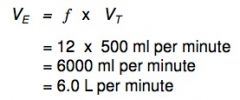
(VE) - amount of air moved per minute calculated by:
|
|
|
Anatomical Dead Space
|
volume of air that doesn't reach alveoli (air remaining in conducting passages - trachea, mouth, etc)
|
|
|
Alveolar Dead Space
|
if alveoli cease in gas exchange (e.g. damage or lined with mucus)
|
|
|
Total Dead Space
|
(Vd) = Anatomical Dead Space + Alveolar Dead Space
|
|
|
Alveolar Ventilation (VA)
|
amount of air reaching alveoli each minute
Calculated as: |
|
|
Measurements of airflow: Respiratory volumes
TV |
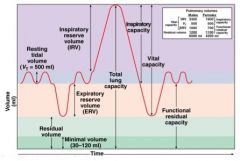
TV = volume of one breath
|
|
|
Measurements of airflow: Respiratory volumes
IRV |
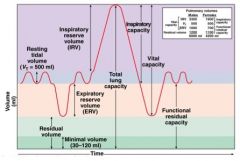
IRV = volume inhaled with maximum effort in excess of tidal volume
|
|
|
Measurements of airflow: Respiratory volumes
ERV |
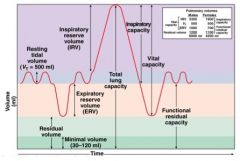
ERV = volume exhaled with max. effort in excess of tidal volume
|
|
|
Measurements of airflow: Respiratory volumes
RV |

RV = volume remaining in lungs after max. expiration (keeps alveoli inflated)
|
|
|
Measurements of airflow: Respiratory capacities
VC |
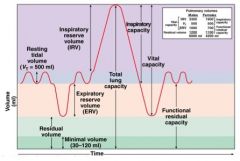
VC = volume exhaled with maximum effort after maximum inspiration
|
|
|
Measurements of airflow: Respiratory capacities
IC |

IC = volume of air inhaled after normal tidal expiration
|
|
|
Functional residual capacity
|

Functional residual capacity = volume in lungs after normal tidal expiration
|
|
|
Total lung capacity
|
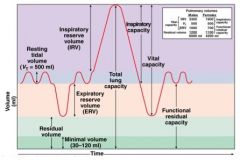
Total lung capacity = maximum volume lungs can contain
|
|
|
VC =
|
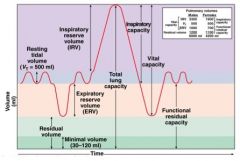
ERV + TV + IRV
|
|
|
IC =
|

TV + IRV
|
|
|
Functional residual capacity =
|
ERV + RV
|
|
|
Total lung capacity =
|
VC + RV
|
|
|
Pulmonary function tests
|
used to asses one's respiratory status (compared with "normal" values)
|
|
|
spirometer
|
instrument used to measure different volumes of breathed air (water is displaced by the breathed air, and the volume can be recorded)
Helpful in distinguishing obstructive or restrictive disorders |
|
|
Obstructive disorder
|
difficult to get air out of the lungs (expiration)
• emphysema, bronchitis, and asthma |
|
|
Restrictive disorder
|
difficult to get air into the lungs (inhalation)
• mascular diseases, chest wall deformities |
|
|
Gas exchange occurs between air in ____ & ____
|
alveoli & blood → across respiratory membrane
|
|
|
Gases are exchange by diffusion in response to a ____ ____
|
concentration gradient
|
|
|
To understand how gases are exchanged between air in alveoli & blood you will need to consider:
|
1. Partial pressure of gases (Dalton's Law)
2. Diffusion of molecules between gas & a liquid (Henry's Law) |
|
|
Dalton's Law of Partial Pressure (PP)
|
• Total pressure (of gas mixture) = sum of individual gas pressures... called the partial pressures
• The partial pressure of each gas is directly proportional to its percentages in the mixture Partial pressure (PO₂, PCO₂ is the driving force for diffusion of gases • Gases diffuse from high to low pressure (down their own concentration gradient) Composition of Air: Nitrogen ~ 78.6% Water vapor ~ 0.5% Oxygen ~ 20.9% Carbon dioxide ~0.04% Atmospheric Pressure = 760 mm Hg Each gas above contributes to the total pressure → in proportion to its number of molecules (or its partial pressure) All partial pressure of molecules in air together add up to 760 mm Hg (atm pressure) |
|
|
If you have a container with 4 gases:
50% CO₂ 25% O₂ 12.5% N₂ 12.5% CH₄ Total pressure in the container at: 800 mm Hg According to Dalton's Gas Law; what is the partial pressure of CO₂, O₂? |
CO₂ = 400 mm Hg
O₂ = 200 mm Hg N₂ = 100 mm Hg CH₄ = 100 mm Hg |
|
|
Henry's Law of Dissolves Gases
|
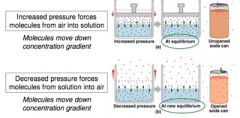
• When the mixture of gases is in contact with a liquid, each gas will dissolve in the liquid in proportion to its partial pressure
• The greater the concentration of a particular gas → the faster it will go into solution • At equilibrium - partial pressure in 2 phases (gas & liquid) are equal |
|
|
Forced Exhalation includes respiratory accessory muscles such as:
|

internal intercostals and abdominal muscles
|
|
|
Force Inhalation includes accessory accessory respiratory muscles such as:
|
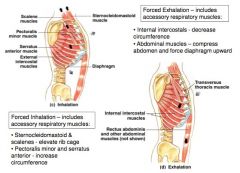
Sternocleidomastoid & scalenes and Pectoralis minor and serratus anterior
|

